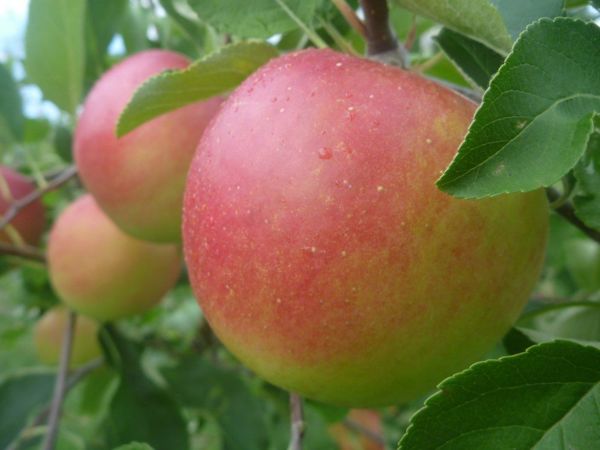An attractive, highly disease-resistant apple, ideal for organic growers.
Sansa Apple on G.11 (Spring 2024)
One of the best early apples, sweet and disease resistant. Also known as Morioka #42.
Somewhat resistant to fireblight, powdery mildew, and scab, and very resistant to cedar-apple rust, this tree is suitable for the organic orchard or the home garden. Early harvest also means that sooty blotch and fly speck will never be an issue. This is a productive tree but low vigor. The leaves show a genetic chlorosis (yellowing) that is not a result of any disease.
Sansa marks the beginning of "real" apple season. Sure, we've picked the Pristines and eaten one or two William's Prides, but Sansa is the first really fun apple of the year. The apples have a tropical coloring, bright–almost pink and almost orange–red, and they are lightly flecked with a gold russet. The creamy white flesh has the simple sweetness of a Gala (one of its parents) balanced by the acidity of Akane (the other parent). The flesh is firm, almost woody, and it's nothing like the trendy explosiveness of a Honeycrisp, but it is, nevertheless, deeply satisfying. These apples are for fresh eating; they do not store for more than one month.
Sansa was the result of a collaboration of researchers in Japan and New Zealand. In 1969, a team of Japanese researchers in Morioka sent the pollen of an Akane tree to Dr. Don McKenzie in Havelock North, New Zealand. This pollen was used to fertilize a Gala, and the seeds of the offspring were sent back to Japan, where the new variety was evaluated for almost 20 years before its release in 1988. If only all international relations had such happy outcomes.
The Fruit
Fruit Type
Category: Apple
Subcategory:
Disease-Resistant, Cold-Hardy, Hot-Climate
Fruit Uses & Storage
Uses: fresh eating
Storage duration: one to three months (approximate, depending on storage conditions)
Fruit Appearance
Skin color: red
Flesh color: off-white
Fruit Origins
Parentage: Akane x Gala
Origin: Japan
Introduced in: 1988
Introduced by: Dr. Yoshio Yoshida and Dr. Don McKenzie
The Environment
Calendar & Geography
USDA zones: 4 - 8
Chill hours: Not yet determined
Ripening date: Sep 01 (approximate, in New York State) 14 days before McIntosh
Tree Height & Spacing
glossary
Rootstock: G.11 Rootstock
Rootstock size class: Dwarf (25% of Standard)
Tree spacing (natural spread of tree): 8'
Good for wildlife planting? N
Diseases & Pests
glossary
Fireblight: Resistant
Powdery Mildew: Resistant
Apple Scab: Resistant
Cedar-Apple Rust: Very Resistant
Pollination
Pollination Factors
glossary
Bloom group: 4
Is it self-fertile? N
Is it fertile? Y
Ploidy: Diploid
Rootstock size class:
Dwarf (25% of Standard)
Pollination Partners
This table shows the first few results from a full search for pollenizers of Sansa Apple on G.11. Please see our Pollenizer Search to run other queries and read how the application uses various factors. Also read more about fruit tree pollination.
See all pollination matches for Sansa Apple on G.11
Featured Products
A few things we're loving right now...
A full-flavored, freestone white peach.
One of America's oldest apples, good for storage, baking, and cider.
A widely-grown, large, yellow-fleshed nectarine.
















